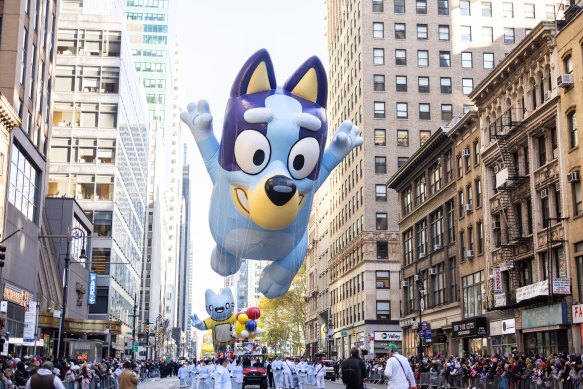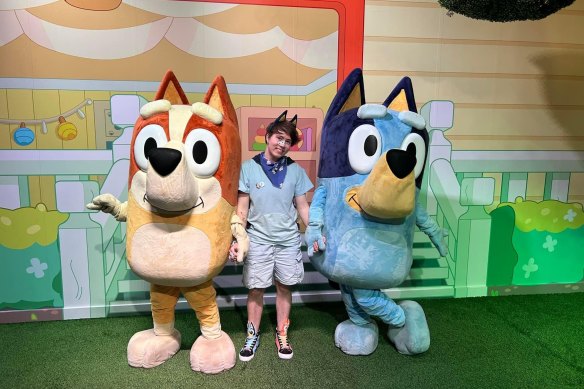M.A.S.H, Seinfeld ... Bluey? Why a show set in Brisbane is taking over the world
I’ve been fascinated by the global popularity of Australian kids program Bluey since the Queensland government hinged its latest tourism campaign on the show in June.
A month later, my curiosity was further piqued by an enthusiastic American couple in a bar in Japan. The dad basically lunged at me when I told him I was from Brisbane. “DO YOU LIKE BLUEY?” he cried with the kind of fervour reserved for teenage girls talking about their favourite pop star.
Having watched my fair share of the show, I’m not surprised by Bluey’s popularity. But I’m struck by the cultural transcendence of this humble story set in suburban Brisbane – a place I found painfully unremarkable growing up.

Bluey featured in the 2022 annual Macy’s Thanksgiving Day Parade in New York. Credit: Bluey Official Website/BBC
Bluey has been exported to 60 countries, and just this week it became the most-watched TV show in the US in 2024. As media analyst Steve Allen told the ABC, 35 billion minutes of viewing by American fans put Bluey in the same league as M.A.S.H and Seinfeld – which, honestly, blows my mind.
To dig deeper, I asked members of the California-based Facebook group Adult Bluey Fans to illuminate me on America’s love affair with the show.
Responses – of which there were plenty – mostly mirrored the show’s popularity with Australian audiences. People love Bluey because of its wholesomeness, humour and realistic depictions of family life.
“It seems to be intended for co-viewing,” said Kurt Swenstein, a content producer based in New York.
“For me, the show’s about parenting, but for [my daughter] Hanna, it’s just a fun show.”
Admiration for Bluey and Bingo’s parents, Bandit and Chilli, was a common response.
“Bandit to me is an idol and the kind of father I hope I can be when I have kids,” 23-year-old Sterling said. When the technician started watching Bluey, he thought it was just “another funny dog show”. He became invested because of Bandit.
Kali said the show had pushed her “to be a more engaged mom”; Ryan called Bandit “my hero”; Deepti explained that Chilli and Bandit had inspired her and her partner “to be more patient with our kids”.
Cassandra described Bluey’s mum and dad as “perfectly imperfect parents”, adding that she solves her own parental conundrums by asking, “What would Chilli do?”
The most fascinating responses came from fans – many childless and in their 20s or 30s – who watch Bluey for comfort and healing.
Twenty-six-year-old Michigan fan Shay said Bluey’s “gentle parenting” had helped heal his own childhood trauma. “The show displays techniques of child-rearing that include making the child feel heard and understood,” he said.

Self-described “Bluey Mega Superfan”, 26-year-old Michigan resident Shay Mosher, loves the show’s depiction of “gentle parenting” and praises it as “an astounding work of art”. Credit: Shay Mosher
“Watching this heals some childhood wounds of feeling misunderstood, but also gives me extreme hope for the children and parents of the future.”
Katie shared a beautiful response about watching Bluey while on psychedelic mushrooms, when she experienced magical “tiny but intense emotional roller coasters each episode”.
The first time she watched Bluey was during a stay at a psychiatric hospital last year. “I deal with multiple mental illnesses ... every time I [could] control the TV channel, I’d look for Bluey ... it became THE thing to watch in our unit.”
In a video last year, American-based Australian YouTuber Margaret Thompson explored why adults and teens in the US love Bluey. She said many of the comments were “about healing trauma from childhood and showing people how to be loving parents”.
The show’s apolitical nature is also appealing. “Because it’s Australian, [it’s] uniquely viewed and loved here by both sides of the political spectrum, which is fascinating,” she said.
“It’s very rare for any TV show over here to have fans who are both Republican or Democratic, religious versus not, and even strict versus gentle parents.”
Californian resident Marcy said the show’s “wholesomeness” was particularly needed right now.
“American culture has shifted far away from wholesomeness over the years, especially lately, to the point of demonising a strong, adjusted, wholesome and complete nuclear family,” she said.
A good chunk of American respondents praised Bluey’s suitability for neurodivergent people, both young and old.
Colorado dad Jason’s daughter has ADHD and finds the show calming. “It isn’t overly stimulating or flashy like so many cartoons in the USA,” he said. Alison said characters with neurodivergent traits made her feel seen and connected.
The show’s unabashed depictions of Australian life and culture, including referential humour and idioms delivered in an earnest suburban dialect, is another explanation for Americans’ love of the show.
But above all, what defines Bluey’s US success seems to be its universality. It captures what it’s like to be a parent, child, neighbour, family member or friend, whether you’re in Boston or Brisbane. The exact formula might never be fully comprehended, at least until Joe Brumm’s brain has been donated to science.
Start the day with a summary of the most important and interesting stories, analysis and insights. Sign up for our Morning Edition newsletter.